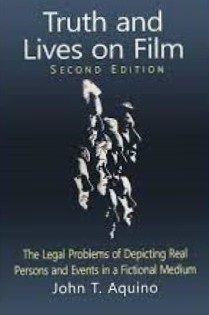Member-Author Book Group talk explores limits for fabrications of real persons portrayed in film
Long-time legal journalist and National Press Club member John T. Aquino described the practical limits for film studios in changing historical facts to seek better box office and creative results, during a recent virtual event sponsored by the Club's Member-Author Book Group.
Aquino, an attorney who retired in 2017 as a senior legal analyst for Bloomberg Law, drew from the 2022 second edition of his “Truth and Lives on Film: The Legal Problems of Depicting Real Persons and Events in a Fictional Medium.” He described how he first became interested in the issue, at age 11, when he noticed a disclaimer in the credits of the 1941 film “They Died With Their Boots On,” starring Errol Flynn in a fictionalized portrayal of the life of Lt. Col. George Armstrong Custer, who died at the Battle of Little Big Horn.
 “What does that mean?" Aquino recalled asking his father about the film’s historical accuracy disclaimer.
“What does that mean?" Aquino recalled asking his father about the film’s historical accuracy disclaimer.
The book represents his answer, elaborated in 17 case histories about those seeking redress for fabrications that could be devastating.
Offering context, Aquino noted that film creators and audiences have recognized since the Silent Era that films condense real-life history for dramatic purposes.
“The issue should be,” he said, “how true is it to the spirit of the events and the characters?”
Further, Aquino explained, creators must avoid legal liability, with libel suits the biggest threat.
A pivotal legal case he described involved “Rasputin and the Empress,” a 1932 MGM film portraying Tsarist Russian court adviser Grigori Rasputin as sexually attacking a princess with a fictitious name. A princess won libel settlements worth more than $20 million in today’s dollars even though the “victim“ in the film may never have met Rasputin in real life.
Out of that arose the standard practice of disclaimers in the final film credits asserting that the films do not necessarily portray real people, dialog or events.
He described the disclaimers as only one tool for avoiding liability. More important, he said, is standard libel law that requires almost everywhere that a plaintiff be alive to seek damages. Family members have no standing, he said.
Most such libel suits have failed, he said, prompting the aggrieved to pursue such additional grounds for damages as invasion of privacy or misappropriation of images.
Aquino, a Club Silver Owl, said misleading films can corrupt history in important ways even if no legal redress is possible. That occurred, he said, in the Custer film, which falsely portrayed Custer as having noble motives. The film was, however, one of the top-grossing films the year it was released. It also starred Olivia de Havilland.
Aquino, an active member of the D.C. and Maryland bars, also talked a bit about his second book published this year, “The Radio Burglar: Thief Turned Cop Killer in 1920s Queens.” Launched Sept. 20, it portrays police tracking down a murderous burglar who specialized in stealing valuable radios at that sector’s beginning.
Asked why he authored the tale, Aquino said his aging mother-in-law enjoyed during her twilight years recounting a family link to the expert sleuthing. “It started as a labor of love,” he said of his conversations with her and his 15 years of research, “and it ended as a labor of love.”
The Member-Author Book Group produces events for Club members to promote their recently published books. The group currently meets virtually at noon on the second Tuesday of the month. To inquire about the group, contact Joe Motheral at joegm35@ aol.com.
